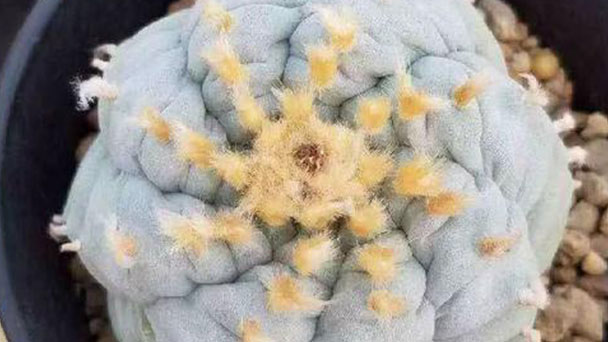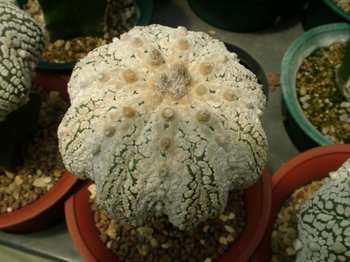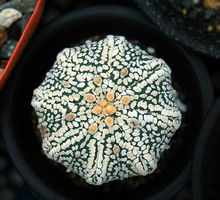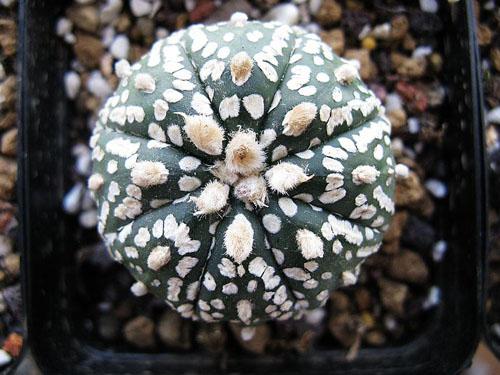Astrophytum asterias (sand dollar cactus) profile
Written by Maggie
Aug 27 2021

Astrophytum asterias, also known as sand dollar cactus, are cultivated species of the saccharum. Astrophytum asterias is one of the representative species of cymbidium and endangered species. It is spherical at the beginning, oblate spherical and even disc-shaped at the end, 5.5 cm high and 10 cm in diameter. The epidermis is grey-green and shiny, scattered with clumped curls, commonly known as stars.
Astrophytum asterias picture

Morphological characteristics of Astrophytum asterias
Astrophytum asterias are spherical at first, then oblate spherical and even disk-shaped, with a height of 5.5cm and a diameter of 10cm. Their epidermis is grey-green and shiny, scattered with clumps of curly hair, commonly known as stars. Usually 8-rowed, sparse 6-10 rowed, straight and neat, rounded ridges. Flowers are 3 cm long, funnelform, yellow with red throats. Fruit mature base dehiscent, seed cap - shaped, black or red - black.
Ecological habits of Astrophytum asterias
Astrophytum asterias like dry environments, drought tolerance, like full sunshine, big temperature difference, good drainage rich limestone sandy soil. When the temperature is lower than 7℃ in winter, indoor warmth can be placed at night.
How to grow and care for Astrophytum asterias
Astrophytum asterias have small plants, few pests and diseases, and often bloom, making them ideal for family cultivation. A well-drained, fertile soil is required, such as a calcareous material added to the soil to prevent skin Browning. astrophytum asterias is suitable for shallow pots, easy to grow from roots. However, grafting on a scale allows early flowering and is necessary if rapid reproduction or hybridization is required. Astrophytum asterias is widely cultivated, but the standard plant shape is very few, so the wild bulb of the original place is excavated too much, and it has to be protected.
Soil
The hardest part of putting Astrophytum asterias in the wild into a pot is soil. It is very important to choose soil that holds water but is wet and drains.In terms of water retention, the terra-jade soil is very good for planting thick roots that grow vertically down. Sand - based soils produced pockets with finer roots. Secondly, in order to drain the soil to screen out the particles, so that the problem of root rot caused by too much irrigation is solved, but there is also the problem of easy dry soil, which can only be solved by you to adjust the rhythm of irrigation.
The selection of the basin
From aesthetically speaking, choose to burn pottery and other basins have nothing to say. But from the point of view of cultivation, we recommend the use of black plastic orchid pots. Although ventilation is not good, if the use of the soil above is completely no problem. There's nothing better than a plastic basin in terms of heat. All cactus plants, not limited to hoods, need rising ground temperatures to grow their roots. Warm planters are important, and black plastic pots are ideal in this regard. Also, keep the space between the flowerpots and the flowerpots, and don't forget to give the flowerpots full sunshine.
Take root in the basin
Medium the basin of the following, want to change soil every year, large basin every 2 years change 1 also do not concern.
The method is to put the chicken manure that ferments on the big grain soil at the bottom of the basin to make bottom fertilizer, the surface of the basin spreads the soil with big grain to prevent the ground from running off when watering. Sow Astrophytum asterias a little deeper to add weight. As a rule of thumb, repots in spring do not fail. It takes a temperature of around 40 ° C (around 15 ° C at night) for the roots of the pocket to start moving, which is not possible in March.Flowers begin in late February, and if repotted in early spring with other palmate plants, the low temperatures and humidity will cause root rot, a failure that often occurred in the past. Why to say until July, it is to let the root system grow completely when arriving in the winter, the fatal injury that prevents pocket -- the occurrence of waist crease. Once a crease occurs, although it will return in the spring, it will occur year after year and cannot be cured.
The method of root trimming is to shake off the soil on the root, remove the fine root by hand, and cut off with a razor blade at the bottom of the ball where the thick root is left at 2 ~ 3cm. Let dry for a week and then plant in. When trimming the Astrophytum asterias root, it is necessary to confirm whether there is red rot in the root section, and if there is, it should be completely removed.
In addition to the above methods of root pruning, there is another method of complete excision starting from the rhizosphere of the pocket. In spring, the hood will be pulled out of the soil, the roots will be completely removed and let dry indoors. By mid-March, Astrophytum asterias will be planted. This method can reduce the rot of the hood, but it is provided that the greenhouse and the temperature can be controlled.

Watering
Astrophytum Asterias are very fond of water, so keep the soil moist. Spring ~ autumn of the growing period of 3 days or so (note: here is the sunshine of the shed environment, do not copy) once from the head water, winter dormant period is 2 weeks (note: here is also the shed environment) to a water. Completely cut off water is not good for the pocket physiologically, which is the reason for the waist creases in the pocket. Plenty of sunlight and strong roots make it through the winter.
The distribution of Astrophytum Asterias
Astrophytum asterias are native to the arid deserts of the United States and Mexico.
Uses of Astrophytum asterias
Astrophytum asterias are great for potting.
Astrophytum Asterias are curiously cap-like in appearance. Astrophytum asterias is a small species of cactus, potted suitable for indoor desk, desk and tea table decoration.

Latest Updated
- Benefits of Bugleweed - 7 Science-backed Health Benefits
- Bugleweed Dangers & Side Effects - Is It Poisonous?
- How to Plant Evergreen Trees - What You Should Know
- When to Plant Evergreens - Grow Guide for Evergreen Trees
- 12 Wonderful Evergreen Shrubs for Your Garden
- 12 Popular Evergreen Plants with Pictures for Beginners
- When And How To Prune A Lilac Bush Like a Pro
- How to Grow & Care for Lilac Vine (Hardenbergia Violacea)
- Japanese Lilac Tree (Syringa Reticulata) Care & Propagation Guide
- Shumard Oak Pros and Cons - What to Know
Popular Articles
- Winter maintenance of Antirrhinum Majus
- How to Grow Terminalia Mantaly Tree
- How to Grow and Care for Crossostephium Chinense
- How to grow Antirrhinum Majus in spring
- Peristeria Elata (Dove Orchid) Profile: Info & Care Guide
- Underwatered Snake Plant (Sansevieria Trifasciata) - Signs And How To Fix
- How to Care for Brazilian Jasmine Plant (Mandevilla Sanderi)
- How to Grow & Care for Graptopetalum Purple Delight in Summer
- Rosa Chinensis (China Rose): Plant Growing & Care Tips
- How to Care for Baby Sun Rose (Aptenia Cordifolia)